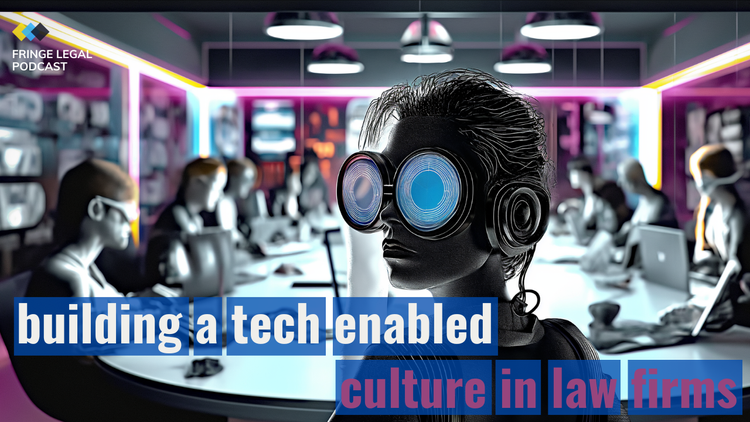Innovation and Transformation Perspectives From Around the World
SUBSCRIBE AND REVIEW: iTunes // Spotify // Pocket Casts // Stitcher
Ab: [00:00:00] Innovation and transformation perspectives from around the world
There is tremendous variability in how the legal industry approaches innovation and technology initiatives, and the range is greater still when you expand the scope to different jurisdictions and regions worldwide.
Through a series of interviews with innovation leaders and a review of published materials. I explored some of the factors that influence innovation levels across different regions. Namely, we focused on the UK., a number of African nations, Australia, and India.
What I’ve found is that many interrelated factors are at play: regional regulations, the maturity of the legal services industry, competitive pressures, and willingness to make financial investments in innovation and technology initiatives. Of course, there are also significant variations across firms within the same region, mostly influenced by the business culture.
Before we consider those factors in depth. We must define what we mean by innovation and evaluate the goals underlying innovative actions.
The spectrum of innovation
Innovation is not a monolith. It runs along a spectrum from the minuscule to the majestic and encompasses technology processes or both.
At one end are incremental changes to existing methods or processes. These efficiency drivers are often small initially, yet over time they could produce marked results. On the other side of the spectrum are seismic disruptions, which may involve doing something in an entirely novel way or something that no one has done before. The disruption reinvents how a firm completes a task or follows a process.
Innovation is, therefore, a process of both incremental changes and seismic shifts. It may affect technology and processes as each will have different primary challenges. With technological innovation, adoption is often the biggest challenge. How do you get users engaged and active with technology so the business yields a positive return on investment?
Process changes on the other hand may or may not involve technology. In these instances often change management is the obstacle to overcome. How do you introduce the change and convinced legal professionals to embrace it? This begs another question. Why innovate at all?
What’s the purpose behind innovation?
Before a firm embarks on a transformation journey, the business needs to establish what it’s looking to accomplish? There are regional factors that introduce a difference in approach, but also common ground to be found. I spoke with Caryn Sandler, Partner & Chief Knowledge and Innovation Officer at the leading Australian from Gilbert and Tobin, who explains.
And I quote.
There is a large variation within and between geographies. with some firms engaging and pushing the boundaries of what can be done in this space, and others only starting the transformation journey. There is now a general recognition in legal of the imperative for innovation and transformation globally, and we’re seeing different ways of achieving that goal plays out within law firms and in-house.
End quote.
These regional variations impact the type of initiative that a firm may undertake. In new and emerging legal markets, it’s harder to justify spending money on technology where the business needs have yet to be proven. Instead, we find that these areas may readily embrace new processes- as they don’t have the inertia of established methods to overcome.
On the other hand, in mature and highly competitive legal markets, law firm and legal service providers can I add value for the client by making incremental efficiency improvements. Those firms are likely focused on adopting technology, getting it off the shelf and into their practitioner’s hand as quickly and as smoothly as possible.
Lastly, some firms are looking to bring the client along on the transformation journey. They can do so by including the clients into technology and innovation design process. These firms often find value in adding a consultancy arm that can provide dedicated innovation services and digital transformation assistance. In all kinds of markets, firms are also exploring how they can pivot perhaps by setting up technology incubators, or otherwise investing in legal technology, startups.
Factors driving innovation, UK, Australia, African nations, and India
While there are numerous forces influencing innovation around the world, I have roughly classified them into four broad categories.
Number one, the legal system and regulatory structure. Number two, the maturity of the legal profession. Number three, the level of competition in the region. And lastly, number four, the sensitivity to spending on technology or innovation efforts.
Let’s consider each of these in turn.
The legal and regulatory system.
Regulations can constrain innovation, and so can the flexibility and makeup or the legal system. There may be more opportunity and less constraint in emerging markets with less regulation and fewer established firms. These open markets can present considerable gaps in service, creating opportunities for firms to innovate and quickly move the needle on providing services.
In more heavily regulated market. The amount of work required to bring about substansive changes is significant and fewer players will attempt to do so. Without a complex web of regulation, law firms have free reign to innovate.
I spoke with Cathy Truter, Head of Knowledge Management at Bowmans a top African firm with offices in seven African countries. And here’s a excerpt from our discussion:
Cathy Truter: [00:06:36] There are pockets of extreme innovation and I think it’s driven by opportunity in the sense that Africa is not necessarily as regulated as some of the offshore countries as I would call them.
And as a result, there is an opportunity to innovate in pockets. Where in other jurisdictions you might be held back by what is the current, and have you go through regulators to get certain approvals and the like It’s in pockets. Innovation has really been fast moving.
So I think that innovative a legal practices correlate quite closely with how innovative the legal sector that they service is. What’s the appetite? So in some pockets, Extremely innovative.
Ab: [00:07:29] Where regulations established cultural differences can still drive an appreciation for innovation. For example, many European countries enjoy a data centric culture that embraces AI data and analytics as elementary parts of their future successes. See notes for a link to a great article discussing this. This attitude is spilling over into the legal profession as well.
Maturity and general culture of the legal industry
The flip side of the regulatory structure is generally the maturity of the legal industry. In largely unregulated areas, the legal sector is nascent and open to new approaches. In heavily regulated areas, the profession can be so establish as to be stifling. For example, in some regions in Europe, the legal in the legal industry has a heavily institutionalized culture, which can make change an uphill battle.
Here’s Cathy Truter again:
Cathy Truter: [00:08:35] If you go to a jurisdiction where they’ve never actually done any of those things, and they now given this new solution and this new opportunity they jump on it, grab it with both hands and they just able to use it to its maximum efficiency.
And I’ve seen it even with the things that we try and roll out where we really have institutionalized processes are far harder to get the lawyers to really adopt the technology and our clients adopt the technology in a way that would really benefit them.
Ab: [00:09:09] There’s a balance to be found here: a region that is starting effectively from scratch may, counterintuitively not be as free to innovate because it’s still. Is figuring out what needs to be done and how to do it. This tension also plays out on the micro level with individual lawyers at the firms.
The junior lawyers – commonly thought of as the most tech friendly – are often consumed with learning the law and the job such that they are less able to appreciate and embrace innovation. As a result, it’s often the experience more senior associates who are the real innovators. These establish practitioners know the law, understand the necessarily results, and grasp innovation’s value in reaching those results much more quickly and efficiently.
Competitive pressure
Countering an established legal markets’ inertia is one of the most significant innovation drivers: business competition. Competitive pressure is perhaps the primary driver of innovation in the UK legal market, which has had to grapple with the big four accounting firms, amongst others ever since the passage of the Legal Services Act 2007.
The act allowed external ownership of law firms, known as alternative business structures – ABS. That pressure has led to some widespread practices, such as firms developing consulting arms to aid clients with legal technology. In a recent example, Mishcon de Reya has launched it’s consultancy, MDR Tech to provide clients with digital transformation advice and legal engineering services. Again, refer to the notes for a link to a great article about that.
The competitive picture is similar in India. A part of the market is dominated by legal process outsourcing firms – LPOs, and independent, practitioners and law firms must decide whether they wish to compete or collaborate.
I spoke with the Head of Artificial Intelligence and Innovation for one of the largest firms in the country, Cyril Amarchand Mangaldas CAM, in New Delhi. She explains in her own words.
Komal Gupta: [00:11:26] LPOs are a class apart in using technology because they do outsourcing work, and outsourcing work as possible because of technology use. The lawyers who are working in LPOs are always going to be tech savvy lawyers and, they will be delivering legal services through technology.
So I think the pandemic has accelerated, the acceptance of technology in India. Otherwise, generally technologies that are very mature or which are easily accepted amongst the lawyers is legal research and contracts. And the third one. I hope they start realizing that proofreading is one of the very important, proofreading tools are good for them to come up with great drafts.
Ab: [00:12:15] In other emerging markets, there may be a question of who firms should consider the competition. For example, going back to Cathy Truter in Africa, she stipulates that.
Cathy Truter: [00:12:28] The jurisdictions in which we have offices are the typical jurisdictions where international clients come to invest in an emerging market like Africa. So you find that majority of our clients are international clients that operate with the best international law firms. So from our perspective, that’s who we benchmark ourselves against.
Ab: [00:12:59] Jumping over an ocean to Australia, similar pressures are at work. The legal services industry there is valued at $21 billion. Check link for an article. And due to the rise of legal services provided by the big four accounting firms and disruption from a more agile streamlined quote unquote new law firms. It’s become intensely competitive.
This has led to intense pressure for innovation and legal technology.
Great link here as well. Check the notes, please.
While many Australian firms are taking a cautious approac, Australia’s thriving legal tech startup scene enjoyed more than $1 billion in investment in 2018. Another great article linked here.
We return back to Caryn Sandler, who notes and I quote:
Culturally, and from a legal system perspective, Australia is well-placed to take advantage of startup and legal operations growth in these geographies and we have a competitive legal market with few large players, which forces many to engage with innovation and transformation. As such, I think we’re seeing a strong focus on innovation in Australia, within law firms and are starting to see in-house teams really focused on this as well.
End quote.
Investment in innovation
Unfortunately, despite the availability of legal technology offerings. Legal department across Australia tend to underinvest, allocating only 4% of the internal expenditure to technology. The source for this is quoted in the notes.
Without investment, innovation can stagnate. Conversely, with the right strategy and investment behind innovation efforts, it’s possible to produce results to advance the business. and the broader profession. For example, the UK firm, Travers Smith recently open source the code for his contract labeling software – Etatonna. Again, check the notes for a source and a link
In emerging markets like India, the economies of scale can make a tremendous difference in technological investment. Because the legal industry’s spending power is only equal to the value perceived by the market, firms – and vendors -have to find ways to establish the market through massive adoption of technology before necessarily seeing a full return on their investment.
To counter that challenge Indian from CAM has launched the second round of its tech incubator. And we go once again to Komal who explains:
Komal Gupta: [00:15:56] Why did Prarmbh happen? Prarambh happened because we wanted to explore domestic legal tech products.
And we realized that as we were exploring, the quality was not that great. people did not have the confidence. there was lack of demand. There was lack of supply. There was lack of investment. and that is why great products were not being made in India, Legal tech products.
And, which is the reason why we’ve had to subscribe to foreign technologies. There are always some shortcomings because the training has not been given, keeping in mind the Indian scenario, the Indian documents, the Indian legal environment. And that is why I think domestic talent can do best justice here, but they need encouragement. They need support. They need investment.
Ab: [00:16:49] Individual from characteristics influencing innovation
Regional factors aside, there are also undoubtedly firm specific characteristics that influence innovative approaches, likelihood and successes.
Firm’s structure and culture, a high on that list along with interest, energy and investment. The more that a firm’s willing to come to the table and talk about innovation and better yet to invest in it the better position that firm will be to innovate.
Gilbert + Tobin is repeatedly recognized as the most innovative firm in the Asia Pacific region. The innovation. Mindset, the innovation mindset must permeate the DNA of the business to find some successes. Here’s Caryn Sandler again, and I quote:
to meet the challenges of tomorrow, the legal operations area of the firm must shift from being considered support i.e. an overhead, to an essential and expected part of high-value legal services.
To this end, we’ve created and nurtured a dedicated Legal Services Innovation, LSI, team to support and cultivate the development of a transformational mindset within G+T.
She continues.
This team is made up of data scientists, management consultants, capability experts, lawyers, and lean and design thinking specialists. By bringing these skillsets together on client matters, we’d leverage our diverse expertise to better support legal service delivery.
End quote.
Innovation is, in a real sense, subject to physical laws of inertia and momentum. And while 2020 has thrown everyone for a loop it has provided an enormous shot of momentum for innovation as capabilities like remote work and transaction management have taken on new importance.
Conclusion
Recognize that innovation and transformation initiatives sits along a spectrum from incremental to disruptive. Understanding the intent behind the project will allow the business to consider the best way to innovate.
As I’ve highlighted throughout innovation approaches vary worldwide, driven by local pressures and constraints. I’m thinking range just as much within an individual firm. However, what is undeniable is that the firm’s culture is critical in directing the shape and pace of innovation. One of my favorites, quotes from the book Three Horizons my Bill Sharpe Is “the unknown off our experience is not the same as the unknown of knowledge Moving into the unknown and making it known in a new way is just what we living things do”
I leave you with that thought And the question:
How will you foster innovation in your practice?






Become a Fringe Legal member
Sign in or become a Fringe Legal member to read and leave comments.
Just enter your email below to get a log in link.